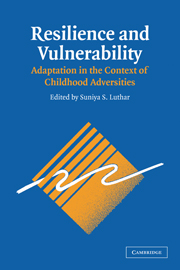Book contents
Foreword by Dante Cicchetti
Published online by Cambridge University Press: 05 June 2012
Summary
For more than three decades, researchers interested in children who develop well in the context of significant adversity have endeavored to enhance understanding of the pathways to psychopathology, to elucidate the processes that eventuate in normal development, and to inform preventive interventions and social policies that could improve the lives of vulnerable children and families (see, e.g., Cicchetti & Garmezy, 1993; Garmezy, 1971; Luthar & Cicchetti, 2000; Luthar, Cicchetti, & Becker, 2000; Masten, 2001; Masten, Best, & Garmezy 1990; Werner & Smith, 1982, 1992). Investigations in the area of risk and resilience have caused scientists to rethink their prior assumptions about the causes and course of psychopathology and have resulted in a reformulation of the deficit models that characterized earlier viewpoints about the development of children who have experienced disadvantage and great adversity (Garmezy & Streitman, 1974; Luthar & Zigler, 1991; Masten & Garmezy, 1985; Rutter, 1985).
Studies conducted on high-risk and mentally disordered populations across the life span frequently portrayed the developmental course as deterministic, inevitably resulting in maladaptive and pathological outcomes. Investigations ranging from genetic and biological predispositions, to psychopathology, to assaults on development associated with inadequate caregiving, traumatic occurrences within the home, and exposure to community violence graphically convey the multiplicity of risks that can eventuate in disordered outcomes.
- Type
- Chapter
- Information
- Resilience and VulnerabilityAdaptation in the Context of Childhood Adversities, pp. xix - xxviiiPublisher: Cambridge University PressPrint publication year: 2003
References
- 13
- Cited by



